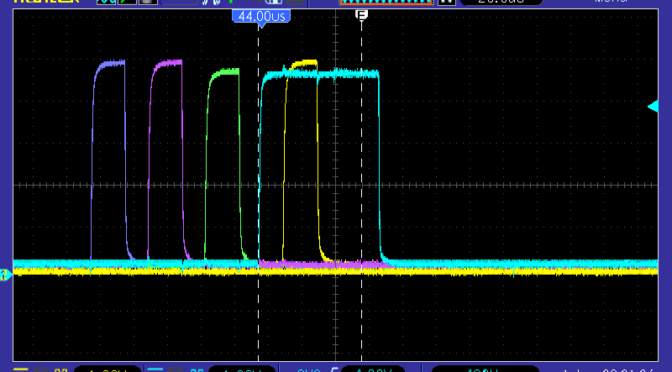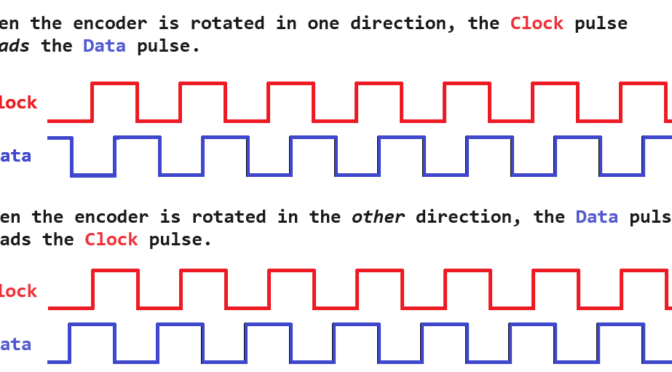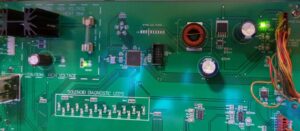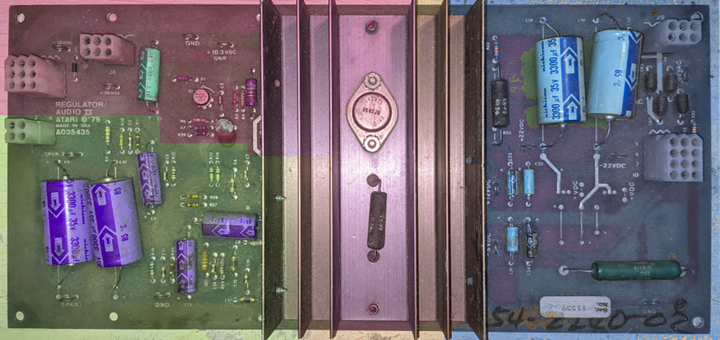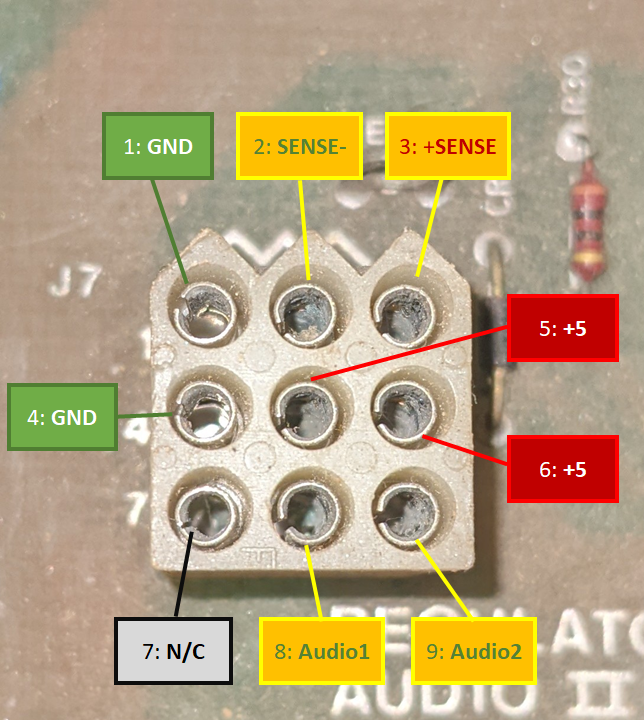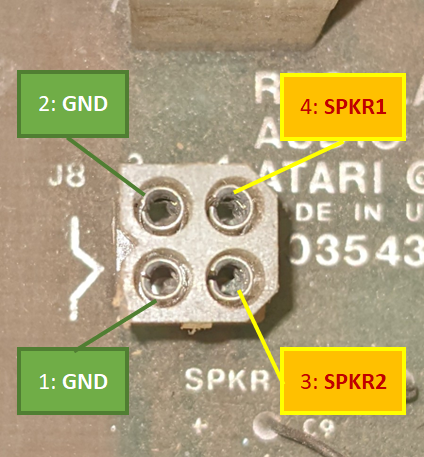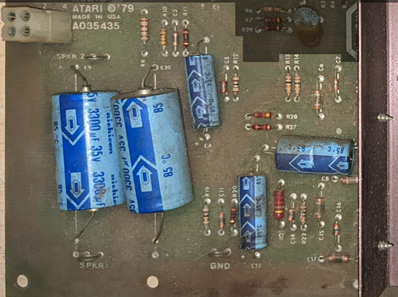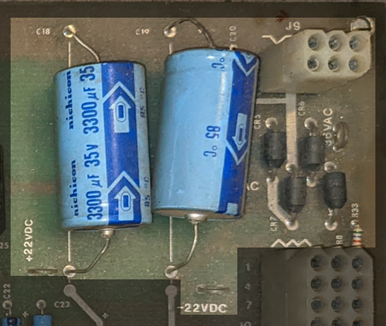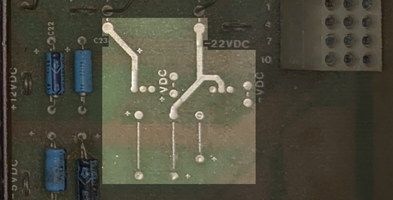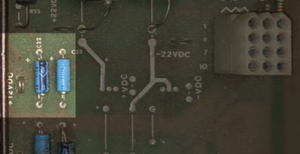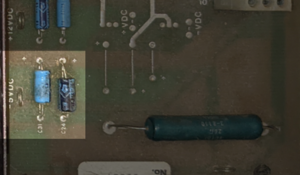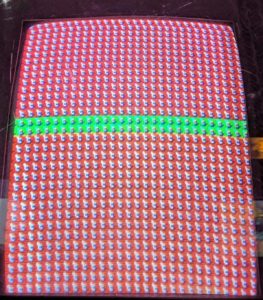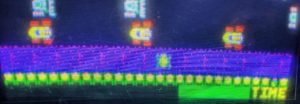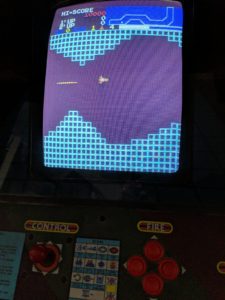I am seeing something across multiple classic Bally pins that makes me think it is an actual bug in the firmware. It has to do with the LATCH signals for the displays. Specifically the Credit/Match/Ball (CMB) display.
Category Archives: Arcade Tech and Repair
This blog contains my previous Arcade Repair Logs moved to blog format. It is also where new repair logs will be created.
Quadrature Encoding Refresher
Quadrature Encoding
…is the method used by mechanical mice, trackballs, and spinners like those used on Tempest and Arkanoid. It works by attaching a movement axis to a slotted wheel and placing the slots in between two optoisolators or optos. When talking about Quadrature Encoding, the two signals from the optos are sometimes referred to as Clock and Data.
Alltek Ultimate Solenoid Driver Board with only the +43 VDC LED lit
So I have a stand-alone Mata Hari headboard that is used for testing purposes.
I previously had a Alltek Ultimate Solenoid Driver Board (USDB) in it that was powering an Alltek MPU board. That USDB was pulled because it was needed for another purpose and I later received a new USDB as a replacement. However, after connecting this one up it only lit up its +43 VDC LED. (Actually, it also lit up its 180 VDC LED, but that has nothing to do with this post.)
Continue reading Alltek Ultimate Solenoid Driver Board with only the +43 VDC LED lit
Bringing Games or Pins to a Free Play Event (e.g. Free Play Florida)?
We all love our vids and pins. And for those of us that repair and/or restore older games, most of us are proud in what we have done to return them working again and bring them back to their former glory. And we might like the idea of sharing them with others at an event like Free Play Florida (FPF) where we can proudly display our games to others and let them enjoy them as much we we do. But if you are gonna contribute games to a Free Play event, there are some things to keep in mind.
(Note: I am strictly speaking for myself here, and not as anyone that is affiliated with FPF. These are my own opinions and experiences.)
Continue reading Bringing Games or Pins to a Free Play Event (e.g. Free Play Florida)?
Replacing Bad Customs’ Sockets on Galaga
Had a Galaga that was reporting false ROM errors and had glitching that made me think that the three CPUs were uncoordinated. For example:
- Game would sometimes play but would have no sound, would play glitchy sounds, or get stuck on sounds
- Game would have odd graphics-related issues during its startup or sometimes during play
- Starfield had incorrect behavior – was moving backwards, was stopped, or moving at the wrong speed
Odd Display Issue in Gottlieb Haunted House pin
So I was helping a friend with his Haunted House (HH) pin. The bottom playfield stopped kicking the ball back onto the main playfield, and the two right score displays and the center credit/ball display would distort on a cyclic basis – they would show all segments in a flash-flash-pause, flash-flash-pause pattern, and this happened when the game was in attract mode, test mode, or being played.
The playfield problem was from the three connectors for the bottom playfield not being routed correctly and he accidentally unplugged them when lifting the main playfield – two of the three of them were disconnected. We routed them through the little slot at the back of the bottom playfield, connected everything up and it all started working again. Continue reading Odd Display Issue in Gottlieb Haunted House pin
Got Screwed by Suzo-Happ
So a site I work with has had two GamePro monitors go down. One of them was from an odd power issue that ended up smoking one of the Zeners on its control board, and the other was just a loose power connector. These boards use a lot of smaller SMT components that I am not equipped to repair
I went searching for a replacement board for the monitor and found some on SH’s web site here (be sure to have a good look at the example image they show). The boards had the same markings, so I bought 3 of them so I could have some spares JIC. Continue reading Got Screwed by Suzo-Happ
Newest Version of AR-II Documentation
Atari Regulator/Audio II (AKA the A/R-II) Version -02 Information
By James R. Twine ©2009-2023
References and Source Material
Information is this document is from personal experience with these beasts and some was stole^H^H^H^H^H… um, I mean… inspired… from many sources including official Atari docs (wiring diagrams, schematics) and Internet-based sources from authors that are far smarter than I, including:
- The Real Bob Roberts
- arcade.melchman.net
- https://bitslicer.tripod.com/ar_SENSE _mod.htm
- VAPS
- UKVAC
- rec.games.video.arcade.collecting (yes, I am THAT old)
Legalese
This document’s content was compiled and written by James R. Twine, ©2009-2023. It can be freely shared or even incorporated into other documentation if an accurate attribution is present. OK, now the common sense warning:
Some of the information in this document may be incorrect!!!
The reader (um, that means YOU) assumes all risk of using or misusing this information. I am not responsible if the information in this document results in damage to your A/R-II (R/A-II), damages your game, burns your house down, gets your sister pregnant, kills your dog, causes you to get divorced, etc. By continuing to read this document and/or apply the information contained within, you acknowledge the above and assume all risks of using the information provided.
We Will Start by Just Getting This Out of the Way…
The notorious SENSE mod. The arcade community seems split on this one. Not exactly a 50/50 split, but more people seem to recommend performing the mod. The rest vote for keeping the SENSE circuit intact, and “simply” performing proper maintenance and/or other mods on the game to alleviate the connectors heating up and burning, which is the primary reason for suggesting that one should disable the SENSE circuit.
Personally, I prefer to learn from history – suggesting that one correctly maintain their game and keep their edge connectors clean is great. But we all know that people just do not do it. So personally, I suggest performing the mod, and directions for doing so are included in this document. Besides, I think it is better to find out that your connectors are going bad by a voltage drop causing the game to stop working, not by your connectors getting too hot and deteriorating further.
That said, you will see people talk about “bulletproofing” an A/R-II, and then they simply go about describing the SENSE mod.
THIS IS NOT BULLETPROOFING!
Anyone that says that simply performing the SENSE mod is bulletproofing1 an A/R-II is lying to you or just does not know any better. Why? Because if the +5V regulation fails it is still possible to end up with more than +5V over the +5V line, which could damage any board connected to it. What kind of “bulletproofing” is that? (Shameless plug: that is why I designed a PCB with an adjustable crowbar circuit – THAT is how you bulletproof an A/R-II!) Anyway – rant over… information on an easy way to perform the SENSE mod is shown below where I document connector J7.
Meet the Atari Regulator/Audio II (mod -02)
This component, affectionately referred to as the A/R-II (“A Are Two” even though calling it the R/A-II would be more correct) was used in many of Atari’s games from the ‘70s and ‘80s. It exists in various forms, from the original Regulator/Audio board used in early B/W games like Asteroids and Atari Football, to the Regulator/Audio II used in many different color games to about the mid ‘80s (e.g. Centipede, Dig Dug, Kangaroo, Missile Command, Pole Position, Tempest, etc.), to the Regulator/Audio III.
Its primary purpose was to supply necessary voltages for the game (logic, audio, and sometimes things like the odd voltages required to erase an EAROM), as well as provide audio amplification. Different versions of the board provided different features like different voltages, more amperage, etc. The image below shows a -02 version.
The board can be roughly divided into 3 areas that are shaded purple, green, and blue in the above image. The middle and upper-left areas are +5V regulation, the lower-left is audio amplification, and the right side is secondary voltages (-5V, +12V, and +/-22V). It is worth mentioning that both “halves” of the board are logically separate. You can apply power to only the left side and get your +5V and audio amps. And you can apply power to only the right side and get your secondary voltages. Both sides do not have to be powered up at the same time.
The connectors are consistent between other versions and revisions of the board, so it may be possible to substitute one for the other depending on the voltages and/or features required. For example, a -03 can usually be used to replace a -02.
Connectors
We will go through the connectors in order of their designations.
J6 – Main Power Input
This connector supplies the power required to produce the regulated +5V and power the audio amps. Note that the +10.3VDC input is unregulated and may normally measure a couple of volts higher when not loaded, such as if you meter it directly on the power brick.
J7 – Main Power Output and Audio Input
This connector supplies the regulated +5V as well as the SENSE lines. It also is where unamplified audio comes into the board.
SENSE Circuit Description and the SENSE Mod
So, how about we stop here for a second to talk about SENSE. You may have heard of the infamous SENSE circuit on these boards, but what does it really do? Well, it is supposed to detect a voltage drop between the power supply and the game’s board. On the game’s PCB the +5V is routed to +SENSE, and GND (the +5V return) is connected to -SENSE. The A/R board uses the voltage coming back on the SENSE lines to determine if it needs to bump up the voltage to compensate for any voltage drop that occurred on the way to the game’s PCB (though the wires, connectors, etc.). Sounds like a good idea at first, right?
Well, now throw in a failing +5V connection to the board – like a dirty connection or a physically failing one. As more and more voltage is lost, the SENSE circuit will keep boosting the voltage, which can lead to overheating and exacerbate the failing connection. Remember that the +5V and +SENSE are connected on the game board? Well, if the +5V connection fails badly enough, the game might try to draw current over the +SENSE line. This is the cause of the infamous smoking of R30 (and sometimes R29) – the game is trying to draw multiple amps across that poor little ¼ or ½ watt resistor.
So, the SENSE mod tricks the SENSE circuit into always seeing exactly what the A/R board is putting out. This is done by connecting +5V and +SENSE together, and GND and -SENSE together, on the A/R board itself. The easiest(?) way to do this is to turn the A/R board over and solder a jumper between pins 1 and 2, and another one between 3 and 6 on connector J7. Note that after doing this, you may have to manually adjust the +5V pot to get a solid +5V at the game board.
It is also worth noting that if you ever need to bench test the board or adjust the voltage using the pot at R8, make sure that the +SENSE line is connected back to the +5V line either via the mod or by connecting-up a game board. The +SENSE line is what is connected to the feedback input on the +5V regulator and and this feedback circuit is necessary for the board to work correctly. If you think you will be benching a lot of these boards, it may be worth created a plug that mates with J7 and wires-up the SENSE lines accordingly.
J8 – Speaker (Amplified Audio) Output
This is the amplified audio (Speaker) connection. If you are used to seeing positive and negative speaker signals, consider the SPKR1 and SPKR2 signals to be the positive ones, and the GND to be the negative ones.
J9 – Secondary Power Input
This connector provides the 36VAC (note – AC, not DC like on J6!) input voltage to the board which is necessary to generate the additional +12, +/-22, +/-15, and -5 voltages. Not all A/R boards are stuffed to produce all the secondary voltages. On the board shown in this document, the area that would be used to produce the +/-15V is unpopulated.
J10 – Secondary Voltage Output
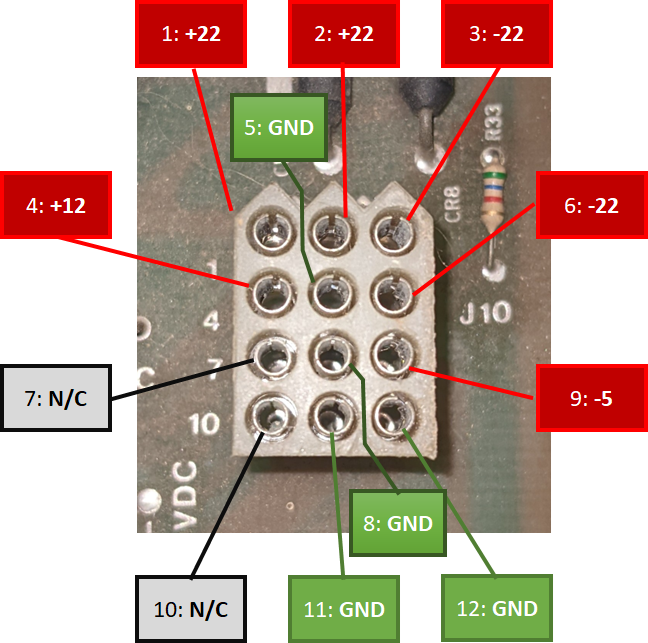
This connector provides the additional voltages produced from the 36VAC provided on connector J9. (Pins 7 and 10 would be the +/-15V if it was present on this board.) Also note that the +/-22V is unregulated and directly connected to the bridge’s filtered output, so do not be surprised if you see a higher voltage when unloaded.
Operation
Here I will try to describe how this A/R board works.
Primary +5V SupplyThe primary +5V supply derives from the Excessive voltage or no voltage on the |
Audio AmplifiersAudio amplification is provided by the two TDA2002(AV) amplifiers. If you are having problems with distorted sound, I would start with the two larger output coupling caps, C9 (SPKR1) and C10 (SPKR2) before looking at the amplifiers themselves.
|
Troubleshooting
This section covers a few things that might help with troubleshooting and repair of an A/R-II.
First is a good adjustable power supply to produce the +10.3V for the primary side and either a transformer that will output ~36VAC or a variable one for the 36VAC for the secondary side. I recommend working with one side at a time.
Next is to get a good quality 2-ohm, 20 W cermet resistor. When briefly connected between +5V and GND it will pull 2.5 amps and I believe this is a suitable load to test the +5V line with.
If testing on a bench, be sure to either have the sense mod performed or jumper together the +SENSE+5V-SENSEGND
Problem/Symptom |
Possible Cause(s) |
+5V is present and seems stable when measured while unloaded but drops to a much lower voltage when loaded. |
1. The 5V regulator may have failed.
2. The 5V regulator is working, but the board cannot provide the additional current that would normally be provided via Q2 and/or Q3, so one or both may have failed (likely just Q3). |
No +5V present, audio amplification seems to be working. |
1. This could mean that the 5V regulator has failed.
2. This could mean that the 5V regulator is working, but the board cannot provide the additional current that would normally be provided via Q2 and/or Q3, so one or both may have failed (likely just Q3). |
No +5V and no audio amplification. |
Check 10.3VDC input and fuses on power brick. |
| One or more audio channels is not working. | The amplifier for that audio channel may have failed – the TDA2002 at Q5 for SPKR1 and/or the one at Q7 for SPKR2. |
| One or more audio channels are distorted. | The output coupling cap for that audio channel may be leaky and need to be replaced – C9 for SPKR1 and/or C10 for SPKR2. |
+5V has excessive ripple present or the game is experiencing excessive crashes, resets, visual artifacts, odd behaviors, etc. Sometimes an audio hum can also be heard. |
Check the large filtering capacitor (the “Big Blue”) on the power brick. |
Secondary voltages have excessive ripple present (especially noticeable on the +/-22V). |
Check the two large filtering capacitors on the right side of the board – C18 and C19. |
| Secondary voltages are missing a polarity or a reduction in output is voltage is present | One or more of the diodes that comprise the full-wave bridge rectifier on the right side of the board may have failed – CR5, CR6, CR7 or CR8. |
| Missing one or more of the regulated secondary voltages. | The regulator for the associated voltage may have failed – the 7905 for the -5, or the 7812 for the +12. |
| Pulling too much current on the 36VAC (blown fuses). | One or more diodes in the bridge may have shorted – CR5, CR6, CR7 or CR8. |
Component Layout and Parts List
The following is a redrawn parts layout for this A/R-II board. Location may not be precise or exact down to a millimeter but should allow you to locate and identify components of interest. A parts list is also included.
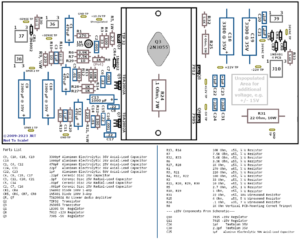
Modifications
Converting a -02 to -03
The version -03 of the AR-II is almost identical to the -02 but with a few changes for the increased current demands of Missile Command (and Monte Carlo?). The differences are:
R25 – a 4 ohm 5W resistor, is replaced with a jumper (or you might see a black zero-ohm resistor)
R31 – a 22 ohm 10W resistor is replaced with a 15 ohm resistor
This also means that you should be able to safely substitute a -03 for an -02 if necessary.
[1] You do not wear a bulletproof vest to prevent things from going wrong, you wear one for when things do go wrong. If you are not able to completely prevent or robustly handle a catastrophic failure, I would suggest that you are not bulletproofing.
Schematic
Here is a mostly searchable PDF of the schematic: AR-IISchematic(OCR)
Galaga Board with Enhancement Pack not Booting
I finally got around to working on a Galaga board for AM and I got it up and running and was leaving it on for a 24-hour test when it crapped out showing a error on ROM 39 (which does not exist). This eventually degraded into a state where it did not display any errors at all, and just seem to hang up at the nonvolatile memory test (NVM OK), and started playing random sounds.
Continue reading Galaga Board with Enhancement Pack not Booting
Theory of Operation of the Shaq 27722-1 (A23) LED Display Board
Theory of Operation of the Shaq 27722-1 (A23) LED Display Board (4-player score board).Theory of Operation of the Shaq 27722-1 (A23) LED Display Board (4-player score board).
Theory of Operation
This is a brief technical introduction to the operation of the 27722-1 (A23) board. It will cover inputs and behavior of the board.
Inputs
This board accepts the following three control inputs:
- Master Reset (/MR)
- 8-Bit Data (DX0–DX7 – pulled up to +5v/VCC)
- Enable/Strobe for the latches (AX4)
It also accepts +5, common GND, +12 and the +12V GND (both GNDs are connected together).
The incoming 8-bit data is split into two 4-bit words with the low word (DX0–DX3) used for specifying the value to display on a particular LED digit via the ‘4511 (BCD to 7-segment latch/decoder/driver), with DX0, DX1, DX2 and DX3 connected to inputs A, B, C and D (or D1, D2, D3, and D4), respectively. The high word (DX4–DX7) is used for digit selection via the ‘4514 (4 to 16-Line Latch/Decoder/Demultiplexer), with DX4, DX5, DX6 and DX7 connected to inputs A, B, C and D, respectively.
Latches for the corresponding chips are controlled via the AX4 signal, which is directly connected to the 4511’s /LE input and also goes through an inverter whose output is connected to the 4514’s LE.
The /MR signal is connected to the 4511’s /BI signal, which is used to blank the displays whenever the game is in reset.
Continue reading Theory of Operation of the Shaq 27722-1 (A23) LED Display Board
Pac-Man With Strange RAM Issue
So I was working on a Pac board for a friend that was dying at boot with symptoms of bad VRAM. I swapped out all of the RAMs only to have the problem persist. Continue reading Pac-Man With Strange RAM Issue
It is not Lag, That is how it Played!
So I was taking with someone about the Arcade1Up units and admitted that I really liked the Capcom fighter ones (upright and cocktail) ones because they included the original Street Fighter. He said they he hated it because of the “lag” in Street Fighter, and how he does not like most multiboards because of the same thing. But what he is calling lag, is not really lag!
Spies Cross Reference List
There is an old cross reference list archived on Spies and replicated by a few arcade-related sites. I took this list and reformatted it, removed empty entries and made some items clickable for easy searching.
Family and Arcade Versions of Pandora’s Boxes
So recently there have been these different versions of PBs becoming available that are very popular with those little self-contained panels that house a two-player setup with a game board and a speaker inside the panel. These used to come with the “real” PBs that used a JAMMA connector:
 But now they use these newer “Family” versions:
But now they use these newer “Family” versions:
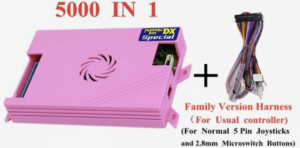
These Family versions should really be called “Home” versions because they have very little to do with an arcade cabinet:
- They do not use a game’s existing JAMMA harness – causing you to either buy another adaptor or rewire your cabinet
- They do not use a game’s existing power supply – so you have to wire another AC power supply into your cabinet
- They do not output the same audio levels (and usually only mono, not stereo), so you might not get the same audio experience or might have to add an external amplifier
- They do not output CGA-compatible video, just VGA and/or HDMI, so you may have to replace the monitor in your cabinet or get a downscaler to convert HDMI or VGA to CGA
- If you run “home edition” and “family edition” into a translator, you get the same output ? (actually, “home” and “family” sometimes produce the same translation depending on the context)
It seems like these Family versions were practically invented for those little self-contained panels. Some of them can run without a harness connected, just a TV, power brick, and some USB controllers! Not exactly “arcade” style, huh? No, these were made for the home market, and should be left as such. Continue reading Family and Arcade Versions of Pandora’s Boxes
Machine Pin Sockets – What Are They REALLY Good For?
So another debate about machine pin sockets vs. standard (dual-wipe) sockets came up on one of the arcade repair-related groups I am a member of. And it, like just about every other older discussion about them, centered around not knowing our understanding what they are really supposed to be used for, and without fail, someone brings up the old “square peg in a round hole” argument. Continue reading Machine Pin Sockets – What Are They REALLY Good For?
Can you “Bulletproof” an Atari AR-II Power Supply? I Think I Can…
Well, like the title initially asks, can you really “bulletproof” an Atari AR-II board? From what I have found on the Internet, and older material like Star Tech Journals, the answer really is no. Pretty much all sources that mention “bulletproof” and “AR-II” on the same page are only taking about performing the Sense mods, and nothing else.
A small amount of pages mention replacing parts (caps, regulators, etc.) due to their age, but that is not bulletproofing either – that is just a good idea. But I think I can actually bulletproof it, and maybe other power supplies as well.
Continue reading Can you “Bulletproof” an Atari AR-II Power Supply? I Think I Can…
WG6100 w/Tempest Showing a Tangled Mess in the Bottom Right Quadrant
So this is basically the second part of a previous post about a tempest that lost deflection.
After running for a while that Tempest’s display changed into something that can only be described as a tangled mess:
That is something that I never had seen before. The owner turned the game off and back on again later that day and it was working normally. Then it would get screwed up again.
Continue reading WG6100 w/Tempest Showing a Tangled Mess in the Bottom Right Quadrant
WG6100 w/Tempest Showing a Multicolored spot in Center of Screen
So I was helping a newly minted arcade game owner when his first purchase, which is his favorite arcade game: Tempest. Shortly after getting it the X-Size pot fell apart and the game ended up only showing a Multicolored spot (larger than a just a “dot”) which changed depending on what the game was doing. We soldered in a larger replacement (dangling from some wires) but while this did change the display a little when the pot was articulated, it did not fix the problem.
He had joined a FB arcade repair group and asked for help there and ended up with ideas ranging from his brightness being too high (it was not – I think the person that responded thought the game was drawing normally but with retrace lines and a white dot in the middle, kind of like how it looks when you’re drawing on an oscilloscope with no Z input), voltages too low (they were not), and one even going down the path of impending AR-II failure(!) and going on about replacing leaky sense resistors and the bottlecap transistor. Oy vey!
Continue reading WG6100 w/Tempest Showing a Multicolored spot in Center of Screen
How a Screen Full of Garbage can be a Diagnostic Indicator
(This is essentially a copy of something I posted in a Facebook arcade repair group not too long ago.)
I was replying to a post that had to do with a game that was showing garbage on screen but was otherwise not working. The type of garbage you see on screen can actually be a good diagnostic indicator. At least, it is a better diagnostic indicator than nothing on screen at all. Continue reading How a Screen Full of Garbage can be a Diagnostic Indicator
Lithium Battery Replacement for Williams and other CMOS Systems
So you have decided to reduce the risk of battery leakage damaging your precious Williams arcade or pinball board by replacing the existing AA batteries with a lithium (CR2032) replacement. Great! Lithium batteries like the CR2032 tend to leak much less than alkaline batteries so this is a good generally a good idea.
Note that I said “much less than alkaline batteries“ – lithium batteries can still leak causing damage to your PCB!
You need to maintain them like any other battery system.
So now the question is, how long will the lithium battery last before it needs to be replaced? I would suggest that you replace the battery as soon as it voltage-under-load drops to 2.8v. Why 2.8? Two good reasons. First, here is a discharge graph pulled from the Energizer CR2032 datasheet: Continue reading Lithium Battery Replacement for Williams and other CMOS Systems
+43 Volt Error on a Alltek Systems Replacement MPU Board
![]() So I was helping another collector in the area try to get a Bally Star Trek Pinball running. It had a Alltek MPU replacement board it in that would start to boot but then stop with 5 diagnostic flashes which indicate a problem with the +43v supply. However, when metered at the test point, the +43v looked grossly normal.
So I was helping another collector in the area try to get a Bally Star Trek Pinball running. It had a Alltek MPU replacement board it in that would start to boot but then stop with 5 diagnostic flashes which indicate a problem with the +43v supply. However, when metered at the test point, the +43v looked grossly normal.
Got in touch with Alltek Systems support and the person suggested disconnecting the sound board and seeing what happened. The game came up with it disconnected, and the support person said there was something wrong with the +43v stuff on the sound board. Right where it comes in there is a diode (CR3) that the collector tested open one way, and about 94k ohms the other.
So a good diagnostic step for this kind of hardware, perhaps even with the original boards in it, is to completely disconnect the sound board and see if the behavior of the game changes.
Update: when I returned to that collector’s house, we lifted one end of the diode and tested it again. Tested open one way but with a lower-than-expected forward voltage drop of about .350v where we expected more for a standard 1N4004 diode. I called it bad and pulled the diode. Had the collector solder in a replacement and the Star Trek came right up!
New Language and Compiler for the Fluke 9010A
I have always been fascinated with the older Fluke 9010A microprocessor troubleshooter. I have owned a few through the years and my current bench one has the serial port on it for transferring programs and data between the unit and a PC.
However, I never found its programming language (usually referred to as 9LC, the name of its compiler) very appealing. It feels more like a cross between assembly and script, and does not seem as flexible as it should be but that might be due to its age. So I sought out to “fix” that.
(The rest of this post was moved to the History page of the 10LC wiki.)
Frogger Problems
So I visited the arcade of someone I have come to know and while taking a look around and playing a few games, I stumbled across this screen on a Frogger:
Not exactly playable, if you catch my drift. Went over the usual stuff, power, reseating, etc. Voltage was a little low, and the power supply could use some maintenance because of a bit of ripple. But was able to get it back up again. When it booted, it booted into an odd screen and I realized it had some kind of HS kit in it. This was actually nice because it included a RAM and ROM test that showed everything passed.
Went into the game and coined it up to play, and saw this:
Pretty sure that we do not want that many lives per game. Seeing that this was a pretty strange issue, I thought to reconfigure things in the HS kit. After readjusting things to 3 lives per game, saving the changes and restarting the game:
Much better, eh?
After fixing something, always be sure to actually try to play it and make sure everything is working right.
Fuse Voltage Ratings
Everyone knows what the amperage rating on a fuse is for and what it means. But do you know what the voltage rating is for? Maybe not what you think.
Quite a few people think that the voltage rating of a fuse indicates the voltage that the fuse will blow (or break) at, like what the amperage rating specifies. In fact, the opposite is true.
Galaga/Bosconian RAM Tip
Galaga uses 4-bit RAMs. This means that in order to handle 8-bit data, it needs to group RAMs in sets of 2 – one for the lower 4 bits, and the other for the higher 4 bits. When Galaga detects a RAM error during the self-test, it does not show the location of the failed RAM, they shows which RAM failed. Continue reading Galaga/Bosconian RAM Tip
Dead Vanguard Board
So I came across a dead Vanguard that was for sale. Described as only producing a boom sound effect and then a rumbling/static-y noise. Bought the thing home along with 1.5 spare boards and did the usual checks: Power, Sockets (reseat), etc. Logic probe on the CPU indicated that it was briefly running and then getting hung up and it looks like there is no watchdog on this game. The sounds being made were from the sound board, which produces its noises without the main CPU being present at all.
Power takes a little longer than I would like to stabilize (several seconds), and was a tad low on the board, but adjusting it did not change anything. It looks like the factory switching supply so it likely could use a cap job.
I got memory map information from MAME to try to figure out the memory map, and got a manual for the game. The manual actually includes a memory map as well as which RAM chips are use in which RAM areas, which is really nice.
Connected up the Fluke 9010 and hit the Learn function. When it was done, I noticed that the results did not match the memory map in the manual. The first RAM section (CPU Work RAM) was not identified at all. Turns out that section had stuck bits (2 & 3). Replaced the socket and the RAM and the game mostly roared to life, with the exception of the power stabilization issue – it takes a few seconds after being initially powered on before the game will run stable so you have to cycle power several seconds after initially powering it up. Monitor could use a cap kit but is in decent condition for its age.
Gonna hit that second board in the near future, initial tests show bit 8 is stuck high.
Quick Fluke 9010 Tip
If you use the Learn function on a board, and it seems to ignore an certain part of the memory map that you know for sure is a certain type (e.g a section of the memory map allocated to RAM), run the appropriate test on that area. Bet it will detect a problem with it.
I recently performed a Learn on a board and it failed to identify an area I knew to be RAM. Turns out that the RAM had stuck bits, which must have made the Learn function think it was something other than RAM. So now I understand that the Learn function can also be used to spot problems with a board.
Williams Hardware, Switchers and CMOS
So this keeps coming up a few times a year, almost like people completely forget about how to use Google every now and then.
Someone has a Williams 6809 hardware game like Defender, Stargate, Joust, etc. They install a switcher instead of repairing the existing linear supply (which is OK, people have their reasons), and everything works great, except for the fact that they occasionally get CMOS corruption and lose things like settings, bookeeping, and scores.
Is something wrong with the switcher? No, something is just wrong with the CPU.
Watchdogging and Corrupted Centipede (Bad POKEY)
Got to work on a busted Centipede that booted to a white background screen that briefly showed the start of the attract mode (things drawn in green or purple) before crashing, watchdogging and doing it all over again. Test mode would do the same thing as well.
Disabling the watchdog (by grounding the WDDIS test point) did not help as the game would just essentially do the same things but just not reset after it crashed.
Continue reading Watchdogging and Corrupted Centipede (Bad POKEY)
Words to Watch Out For When Buying Arcade Games or Pinball Machines
I have learned through many years of posts, sales, people, auctions, and similar experiences that there are certain words and phrases that you need to watch out for when buying games, boards, etc.
Untested
The first one, and it is a biggie – UNTESTED. Here is the truth: if dealing with a whole game, and it has an intact power cord, it is never “untested” – somebody tried to plug it in and power it on, guaranteed. When dealing with intact games, presume “untested” means “I plugged it in, it did not work” – in other words, “broken.”
Now, sometimes “untested” really does mean untested. For example, if someone just got a great bulk deal on a bunch of boards, and want to move them quickly, they may not want to go through the time and effort of testing each one. For example, it is not worth building an adapter for a board that sells for $50 working when I can sell it for $30 untested – I would spend more than $20 of my time and materials building that adapter.
Things like power supplies may legitimately be untested because they might not want to risk damaging a board because of a bad power supply (not everyone has a rig to properly test supplies under load). Same goes for controls, coin mechs, etc. Might not be worth the time to connect and try out each one.
In general, just presume that Untested means the same as Broken. That way, you are never disappointed.
Worked [time] ago when I put it into storage, on the shelf, etc.
This is another one. “It worked 6 months ago when I put it into storage,” or “it last worked two years ago before I put it on the shelf.” Same as above – play it safe and consider that to mean untested or just broken.
It Just Needs This One Inexpensive Part…
This is another favorite of mine. “It is broken and I am selling it for $100. It just needs this one little inexpensive $30 part and then it will be worth $400, so this is a great deal!” Continue reading Words to Watch Out For When Buying Arcade Games or Pinball Machines
